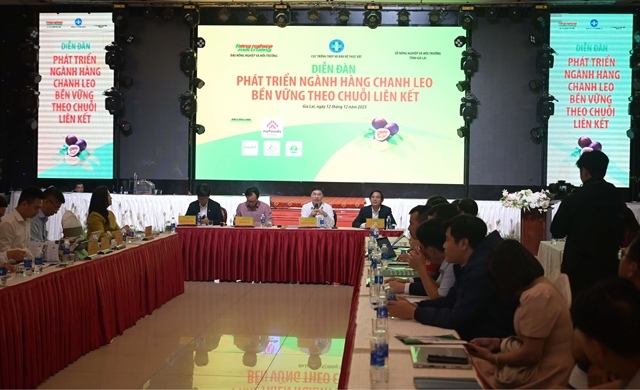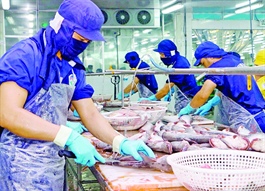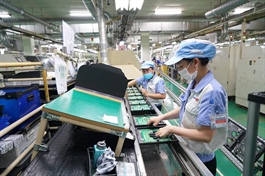VN Trade Promotion Department lauds ASEAN export opportunites
VN Trade Promotion Department lauds ASEAN export opportunites
Vietnamese businesses have many opportunities to increase export goods to Thailand, Laos and Cambodia, according to the Trade Promotion Department of the Ministry of Industry and Trade.

Nguyen Thi Thu Thuy, deputy director of the Export Support Center, said that Viet Nam had many favourable conditions for exporting goods to Thailand and Laos because the three countries were close geographically, and members of various free trade agreements.
To meet the demand of customers in Thailand and Laos, domestic enterprises are recommended to export goods reaching technical standards and to have import certificates from authorities.
They also need to apply advanced technology in processing and preserving products to ensure the quality of products.
They should participate in trade fairs and exhibitions to promote products and find suitable partners, as well as connect to the Viet Nam Trade Office in Thailand and Laos to get market and partner information and support from the office in case of disputes.
At the same time, the enterprises need to build a brand of Vietnamese goods with high quality and competitive prices, according to the Department of Trade Promotion.
Le Thi Phuong Hoa, Trade Counselor, Viet Nam Trade Office in Laos, said Laos was an easy market, importing most of the consumer goods. Besides that, this market also helped Viet Nam export goods to several neighbouring countries, including Thailand. Notably, in the transport sector cooperation from 2021 to 2025, there was the Ha Noi-Vientiane railway.
Those are favourable factors for exporting Vietnamese goods to Laos at a cheaper cost and faster. However, the enterprises should pay attention that goods exported to Laos need labels in the Lao language.
In addition, Vietnamese goods were competing with fake goods and China's cheap goods, Hoa said.
In Laos, Thailand's sales and marketing strategies were very flexible, with a professional distribution channel. Meanwhile, Vietnamese goods were only sold at small stores.
Hoa said one of Viet Nam's enterprises was developing a chain of supermarkets in Laos, but they still sold Thai products to maintain operation and development. That meant Vietnamese goods must compete with Thai products.
Previously, many Vietnamese people did business in Laos, a channel to sell Vietnamese goods, but the COVID-19 pandemic made them come back home. When the pandemic is controlled, they could not return to Laos due to the high costs of entry and living in Laos.
On the other hand, the Russia-Ukraine conflict and increasing fuel prices in Laos led to increased consumer prices and inflation. Those factors make it more difficult to export Vietnamese goods to Laos in the future.
According to Viet Nam Trade Office in Laos, trade turnover between Viet Nam and Laos has grown in recent years. The bilateral trade value growth raised from 8 per cent in 2017 to 13.6 per cent in 2021, reaching $1.4 billion.
In the first five months of 2022, the trade value increased by 21 per cent to $700 million. This figure for the whole of 2022 is expected to reach the same in 2021, maybe even more.
Meanwhile, in Thailand, food is a potential good for Vietnamese exporters because of the great demand. In the structure of imported food products to Thailand, Viet Nam accounts for 6 per cent of the market share, a small figure compared to 40 per cent of the US food and more than 40 per cent for New Zealand food.
According to Nguyen Thanh Huy, head of the Viet Nam Trade Office in Thailand, Thailand is an agricultural country, so Vietnamese farm produce must face competition with the same products of Thailand.
Food and processed products are also the target segments of Vietnamese businesses, but there is fierce competition for those products among exporters.
Moreover, Thailand has strict standards for the food industry, so it isn't easy to import. Vietnamese enterprises without specific strategies for products and markets will find it challenging to compete in this market.
On the other hand, Viet Nam's enterprises should study the market carefully because distribution channels in Thailand are quite diverse, including traditional markets, convenience stores, supermarkets and hypermarkets.
They also need to prioritise healthy food products with low sugar and fat and pay special attention to Thai customers' shopping habits on e-commerce platforms.
In the first five months of 2022, the total trade turnover between Viet Nam and Thailand reached $8.61 billion, up 8 per cent. Thailand is now Viet Nam's largest partner in the ASEAN region. The two countries have set an export value target of $25 billion by 2025.
Viet Nam now exports phones and electronic components; machinery, equipment, tools, spare parts, textiles, garments and seafood to Thailand.
Cambodia market
Le Hoang Tai, deputy director of the Trade Promotion Department under the Ministry of Industry and Trade, said that Cambodia was a potential market for Vietnamese businesses.
The two countries had developed open policies to create favourable conditions for trade activities, but to increase exports to Cambodia, local businesses needed to carefully study this market to increase market shares.
According to Phan Van Truong, head of the Viet Nam Trade Office in Cambodia, Viet Nam and Cambodia have many similar characteristics in terms of culture, market demand and consumption habits. They are favourable factors to help Vietnamese goods enter Cambodia.
In addition, both are members of ASEAN and benefit from regional commitments such as the ASEAN Trade in Goods Agreement (ATIGA). This creates opportunities for investors of Viet Nam, Cambodia and other regional countries to expand investment and development of value chains for export goods to ASEAN countries.
Mai Thi Kim Anh, the representative of an agriculture company said, said that most businesses faced difficulties in customs clearance at Viet Nam's border gates when exporting to Cambodia.
The most significant barriers were often changing procedures and operational methods while working hours for implementing customs clearance were only from 1pm to 4pm.
Kim Anh said that the State management agencies needed to support the businesses to update sufficient information to export goods smoothly to this market. The working hours should be regulated from 8am to 5pm.
In 2021, Viet Nam's export turnover to Cambodia will reach $4.8 billion, up 15.7 per cent compared to 2020.
In the first five months of this year, exports to Cambodia reached $2.6 billion, up 31.2 per cent over the same period last year.
Viet Nam’s main export products to Cambodia include iron and steel, chemistry, plastics, machinery and electrical devices, processed food, confectionery and cereal.
























